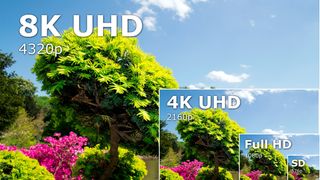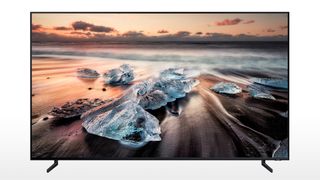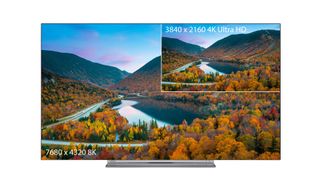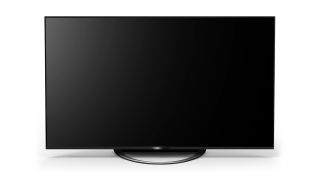Phones and tablets
Best mobile phones
Which one should you buy?
We've played with nearly every device on the market and have found the ten best you can spend your money on. It needs to be good, after all, given it will reside in your pocket for the next two years. Our ranking of the best mobile phones available in the UK today celebrates the brilliance of the smartphone: we love handsets that add in functionality to enrich our lives in so many different ways. We also partially take into account the price of the phone too - meaning a low-price handset doesn't always need to have high-spec functions to be in our top 10.
Best Android phones
Comparing the best Google phones
There's one key way in which Android is massively different from its Apple-branded smartphone competition - the number of phones out there running Google's hot mobile OS. So here they are - the best Android phones money can buy today. For many, many different reasons.
Best Windows Phones
Which Windows Phone 8 handset is for you?
The recently launched Windows Phone 8.1 replicates the popular features of Android and iOS whilst combining the comfort of home computing with the convenience of mobile. We've looked at the Windows Phone devices on offer and picked out the best ones around to guarantee you get the best bang for your buck. Nokia still dominates the list but as a Microsoft entity, that's no surprise.
Best cheap phones
Testing all the best budget blowers!
With the mobile marketplace teeming with a multitude of highly priced smartphones, one might wonder whether cheap phones still have a place in the mobile infrastructure. With massive innovation in both hardware and operating systems, phones now do a lot more than just let you talk and text, with handsets like the Samsung Galaxy S4, HTC Oneand iPhone 5S stealing headlines around the world these days. Sadly all this innovation isn't cheap – and most of it is reserved for high-end contract handsets. So, is there such a thing as the 'best phone on a budget'?
Best phablets
They're big, bad mobile machines
Our hands might not be getting any bigger but our phones certainly are. As flagships like the LG G3 andOnePlus One creep up to 5.5 inches, phablets are starting to resemble small tablets, arguably filling the roles of both a smartphone and a slate. If you think that one device is better than two, or just have really big hands, then there is a growing selection of phones to suit and these are the ten best.
Best tablets
All the top tablets compared
Tablets are taking the world by storm. Just a few years ago they were an unknown for many people, but nowadays you've got more choice than you can shake a mildly agitated badger at. And with choice comes decisions - difficult decisions. Do you eschew Apple's high prices, join the Android brigade and find the best iPad alternative? Or jump on board Cupertino's lovetrain, and use one of the most popular tablets on the planet? We've made it easy for you and pulled together the top 10 tablets of the moment available.
Best cheap tablets
Spend a little, don't spend a lot
Tablets are fast replacing laptops as the must-have computing item, and the good news is that you don't have to spend a lot of money to get one. While the iPads of this world will always be out of many people's budgets, there are plenty of tablets out there available at much lower prices. We wouldn't recommend spending less than £100 on one - you'd regret it - but here's a round-up of our favourite tablets under £250!
Home Entertainment
TV Buying Guide 2014
Choose the right size, screen tech and price
There has never been a better time to buy a new TV. Gone are the days when 32-inch TVs weighed 16 tonnes and cost £1,500. These days you can pick up a 50-inch LCD TV for closer to £300. LCD panel technology has well and truly matured, and while brands like Sony and Panasonic push the boundaries of performance, you'll also find names like Toshiba doing very exciting things in the budget TV sector. The practical upshot of this is that no matter what you're after, how big you want to go or how large your budget is, there's a perfect TV out there for you. So which one is right for you, your family and your living space? In this buying guide, we will walk you through everything you need to know about being a new TV.
Best 32-inch TVs
The perfect size for bedroom TVs or sets for smaller rooms
Most living rooms can't physically take a TV much bigger than 32-inch, making this size by far the best for a lot of people in the UK. But within this size division, there's plenty of choice. A basic HD-ready set can be found for less than £300 is you search hard, though it's just as easy to spend over £2k on the best ones. There's only one certainty at this size – your new TV will be a LCD TV. If you're lucky it could have LED backlighting, but it won't be a plasma; LG used to make plasmas at this size, but there's not one on sale currently.
Best 40 and 42-inch TVs
The sweet spot for plasma TVs offers lots of bang for your buck
Once known simply as 'plasma screens' in the collective consciousness, the 40-42-inch size is where the flatscreen dream started in the late 1990s - and where it's still at its most innovative and best. Now a lot more varied, with plasmas rubbing shoulders with (and quickly being outnumbered by) LCD TVs and their ultra-modern LED TV makeover, 40-42 inches is still the sweetspot for anyone not overly concerned with ruining the interior design of their living room.

Best 46 and 47-inch TVs
Offering the pinnacle of performance, this is where it gets serious
There was a time when plasma screens reigned supreme in the 46-inch TV market. But in much the same way as a meteor strike killed off the dinosaurs, the second coming of the LCD TV is the invasive species that has done for plasma. We're still huge advocates of plasma on TechRadar, don't get us wrong, but the tech is dying out at this size. Old-school CCFL tech has been replaced by LED backlight scanning and technical wizardry to make LCD tech viable in large sizes.
Best 50 and 55-inch TVs
Where the home cinema experience begins
The size where a home cinema turns from dream to reality, it's also at this 50-55-inch TV screen size that 3D starts to become immersive enough to convince and impress. This size, last year dominated by full HD models, is now being overrun by Ultra HD 4K models. While LED tech has gone a long way towards condemning plasma to a role on the outskirts of the TV industry, at 50-inches and above, plasma really comes into its own if you can find one. Most home cinema buffs still swear by plasma, with its cinematic colours and deep blacks making for a real movie-watcher's paradise. But 2014 sees the first batch of 50-inch LED-backlit panels off the production line, a development that further marginalises plasma technology at one of the sizes it previously dominated. If you're looking for a dream movie-watching experience, check out these home cinema beauties.
Best 60-inch TVs and above
If you want the best, you'll need to pay the best
If you're feeling extravagant or want to furnish your big living room with a similarly big TV, 60 inches or more of television will certainly make a statement. There are some truly massive TVs available these days, withUltra HD-toting 84-inch screens such as the LG 84LM960V, Toshiba 84L9300, Sony KD-84X9005A and Samsung UE85S9ST. But for most of us, 65 inches of screen space is luxurious enough, while still being manageable. So what's the best 60-65-inch TV for you?
Best 4K Ultra HD TVs
The latest big thing in big screens
Everyone wants an Ultra HD 4K TV! Yes, okay, we all know there isn't much 4K source material to properly showcase the stunning picture quality, but Netflix has at least started to offer 4K content. There could also still be a 4K Blu-ray format later this year, and before you know it there'll be test transmissions and perhaps even a 4K TV channel from Sky or the BBC. It's all about future-proofing, though there's slightly more to it than that; some of the first batch of Ultra HD TVs pump out best-ever Blu-ray images, thanks to some wonderfully adept upscaling tech. The birth of 4K could also lead to the re-birth of 3D – it just looks so much better at this higher resolution. The big stumbling block – as always – is money, but already there are relative bargains to be had and, better still, some sumptuous designs stuffed with new innovations. The race for 3840x2160 pixels is on.
Best Blu-ray players
From cheap BDPs to UHD players
When big and bulky Blu-ray players first appeared on the shelves nearly 10 years ago they were all about high definition. Back then, simply getting HD content into your HD-ready TV was the hottest ticket in town - and it came at a high price. Those first-gen players are buried in the distant past now, leaving us with super-slim machines with loading times in single figure seconds, 3D Blu-ray playback, 2D-to-3D conversion, apps, streaming to and from smartphones and tablets, home networking, and upscaling to Ultra HD 4K resolutions even before Ultra HD TVs are common. Here are 12 of the best Blu-ray players to help you make your buying decision!
Computing and Laptops
Laptop Buying Guide 2014
Choose the best type of laptop for your needs
With Windows 8.1 here and Windows 9on the way, Ultrabooks taking off in popularity and laptop-tablet hybrids seeing more releases, choosing the right laptop is even more confusing than ever. Cheap laptops, like Chromebooks, are more powerful and capable than ever, while high-end devices are often perfectly good replacements for your desktop computer, able to cope with more intensive programs. Those after a fast boot up time and a lightweight machine to carry might drool over an Ultrabook. While there are lots of options for gamers too. With this guide, you'll find not only that, but which is the absolute best.
Best Ultrabooks
The most premium computing experiences around with the price tags to match
Ultrabooks tend to be made with design in mind, so they come in more expensive than most mid-range home laptops. They tend to start from around $999 (about £584, AU$1,063) in the lower end, going to nearly $2,000 (around £1,169, AU$2,129) at the very high end. You're likely to ultimately spend between $899 and $1,500 for a newer model, though you can get some older models for even lower prices.
Best Chromebooks
Google's Chrome-packed computers make for an unbeatable budget buy
Chromebooks focus on what computing has been all about since the late '90s, the web browser, through Google's Chrome operating system. What should you look out for in a Chromebook? The majority of these Google laptops use either the same or similar low-power components. This is largely what is behind the unquestionable affordability of these mobile rigs – most of which start under $300 (about £175, AU$319).
Best gaming laptops
These machines excel in pixel-pushing performance with panache
Focused on real-time, 3D image rendering for the latest games, these laptops almost always come with a premium attached. If you want (at least something close to) the PC gaming experience with the flexibility to move around the house, the asking price generally starts at $1,300 (about £760, AU$1,384) at the low end and maxes out at around $3,000 (around £1,753, AU$ 3,194).
Best 2-in-1 laptops
Business up front, party in the back – the mullets of the computing world
Otherwise known as hybrid laptops, these devices generally sit in the same price range as Ultrabooks, given their mission to serve as two devices in one. That generally gets you a Windows 8 touchscreen device that either flips around its hinge to become a tablet or detaches from its included keyboard accessory (which hopefully doubles as an extra battery).
Best laptops for students
The tech you need to help you land the career you want
Whether you're a freshman in liberals arts or an MBA looking to rock the business world, you need a laptop that will best enable you for the perfect price. While some will naturally be more expensive than others, these are the clamshells best suited for your field of study and, ultimately, your budget.
Cameras and photography
Camera Buying Guide 2014
The camera buying advice you need
When it comes to buying a camera, you're really spoiled for choice. The range is massive, stretching from cheap and cheerful compact models competing with your smartphone, right through to professional-spec SLRs that cost as much as a decent used car. In this jargon-free overview, we'll discuss the main types of camera out there, to help you make a wise buying decision. You don't want to pay top dollar for features you won't need, but you also don't want to be stuck with a frustratingly basic camera you'll soon outgrow. We're going to concentrate on three main types of camera in this overview – compact, compact system (or mirrorless) camera and SLR.
SLR Buying Guide
Choose the best type of DSLR for your skills and needs
Ever since the arrival of the first commercially viable digital SLRs in the 1990s, there's been a steady stream of technological breakthroughs and new releases. Sales of digital SLRs remain robust, as it's this 'quality' end of the market that is most immune from the threat of ever-improving smartphones; however good smartphones are, if a pro wedding or sports photographer turned up wielding one, they'd get shown the door. There are SLR cameras suitable for every type of photographer, from novices to professionals, but which one is right for you?
SLRs for beginners
Lost of options for the wannabe photographer
If you're a beginner or less experienced photographer who's keen to develop your skills, it's a great time to be buying an SLR – there's a wide choice of keenly priced cameras competing for your custom. Makers are eager to attract beginners in the hope of building loyalty, particularly as SLR users tend to upgrade their lenses eventually, or buy flashguns and other extras. Ideally, you want an SLR that is easy to use, but one that you won't quickly outgrow as your skills and confidence develop.
SLRs for enthusiasts
You're not a pro but you still want a nice camera
While compact system (mirrorless) cameras have eaten into their market share to an extent, SLRs remain the weapon of choice for many enthusiast photographers. It's not hard to understand why; enthusiast-level SLRs offer near pro-levels of performance at an affordable price, are relatively to easy to use, and give access to a massive range of lenses and accessories. Indeed, some enthusiast SLRs rival pro-spec models, blurring the boundary between the two
SLRs for professionals
The best photographers have the best cameras
As you'd expect from a camera costing the same as a decent used car, higher-end SLRs have myriad autofocus options, impressive ISO performance and often (but not always) fast continuous shooting. They tend to be built like tanks too, since they have to meet the demands of professional press, sports and adventure photographers, who are often working in demanding, deadline-driven environments. When it comes to choosing a top-end SLR, the biggest decision is whether to go for a full-blown pro model, such as theNikon D4S, or to save money by opting for a camera that also appeals to advanced enthusiasts and semi pros.
Best compact cameras
Get the best mini snapper for your needs
There are hundreds of digital compact cameras on the market, with advanced, superzoom and rugged camera options all being available, which makes finding the right one quite tricky. The right choice, of course, depends on what you want from your compact digital camera. Maybe you're looking for a high-end compact camera to take the place of your SLR, or perhaps you want something more basic to get a few snaps on holiday. Whichever type you are looking for, we've pulled together a selection of what we believe are the best compact cameras on the market now.
Best high-end compact cameras
The best back-ups to an SLR
The downside of even the latest and greatest DSLR bodies and weighty collections of top-quality glass is that, when a fantastic photo opportunity presents itself, your kit is fast asleep in its gadget bag back at home. In contrast, compact cameras are small and slimline enough to fit into a spare pocket, the glove box of the car, or just about anywhere else. Weighing in at 200-400g (0.4-0.9lbs), these cameras are lighter than most DSLR lenses without a camera attached, but can they really deliver in terms of image quality and creativity?
Best compact system cameras
Get the best CSC for your budget
DSLRs have long-held the title as the most versatile cameras on the market, capable of delivering the highest quality images, robust build quality and advanced functionality, not to mention speed. With compacts and bridge models providing a set of stepping stones up to the traditional DSLR, manufacturers noticed a gap in between that was waiting to be filled: the CSC (Compact System Camera) was born. Fast forward to today and we have an ever-increasing array of CSCs available with varying levels of functionality.
Gadgets and lifestyle
Best sat navs
Find your way from A to B with minimum fuss
Could the car sat nav boast the shortest lifespan of any technology yet? Surely our GPS-supporting phones are more than capable of handling our daily car sat nav needs? Not so fast - there's still plenty of life left in dedicated devices. Apart from offering the kind of focus that is only available from a dedicated device, true sat navs offer proper mounting systems that aren't fiddly plastic nightmares and also pack voice options that entertain and inform. That's not to say that you should leave your phone at home. Phone apps are catching up quickly, and they don't cost the earth either. In fact, some of the most interesting projects are only on phones right now.
Netflix vs Amazon
Which movie streamer is best for you and yours?
The battle of the big American movie streaming services is getting serious: the Amazon-owned LoveFilm is no more, replaced by the new and heavily-promoted Amazon Prime Instant Video. Is Amazon UK finally taking streaming seriously? CanNetflix hold on to its crown as our favourite streaming service? Let's find out.
PS4 vs Xbox One
Which next-gen console is best?
It's a little more even in the PS4 vs Xbox One debate now that E3 2014 has come and gone and we're seven months into the next-generation of video games. Sure, Sony's new console is ahead, pushing toward 8 million systems sold compared to Microsoft's 5 million "shipped to stores" number. But those are sales statistics.
Best printers
Top inkjet and laser printers compared
In choosing the best printer your first decision is whether to go for a standard printer, or a multi-function device which includes a scanner and which can also work as a standalone copier. These aren't much larger than regular printers, but they're a whole lot more versatile, especially when you need to keep a copy of a letter, a bill or any other important document, so our first list includes the best inkjet printers and best multi-function devices. You should also think carefully about whether to invest in an inkjet or a laser. Lasers are usually associated with office environments, where they produce sharp, smudge-free printouts quickly, quietly and economically, but this can be just as useful at home or in a home office.
Best Spotify Connect systems
Control your music wirelessly with Spotify Connect
Spotify is gradually supplanting digital downloads as the dominant way that we listen to music, with 10 million subscribers and 40 million active users across 56 countries listening to its 30 million tracks. With Spotify adding more than 20,000 new songs daily, it's definitely time for Spotify Connect, a new badge for hi-fi gear that enables effortless control of music across a phone, tablet and speakers. Allowing music to be sent direct from the Spotify app to any of these systems, Spotify Connect is a streamer's dream.




